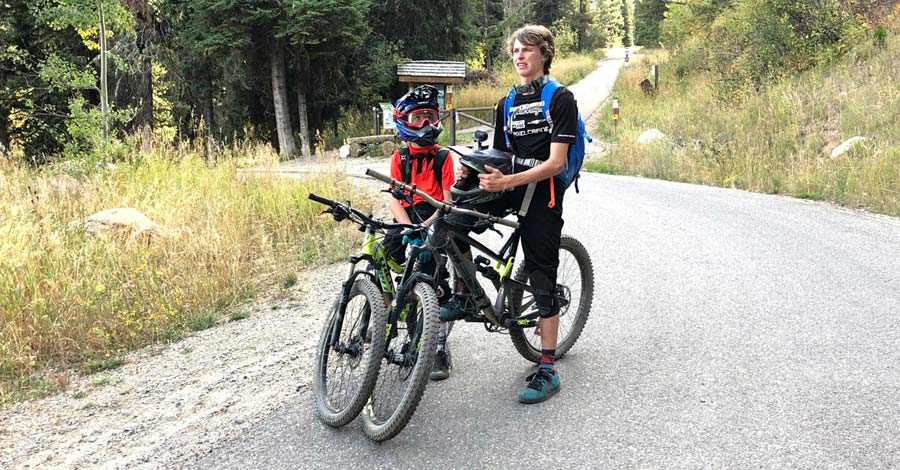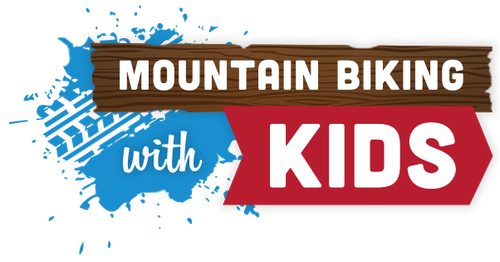10 Things To Know Before Buying A Kid’s Mountain Bike


Mountain biking with your kids is fun, challenging and healthy. Buying a kids mountain bike can be overwhelming. We all want our kids to love being out in nature on their bikes – but that enjoyment is dependent on having the right equipment. Choosing the best mountain bike for your kid can be difficult. Here’s our list of things to consider so you can choose the right kids mountain bike:
Quality Kids Bikes Can Be Expensive
Well-made kids’ bikes can be expensive! When our kids were finally old enough to join us on the trails, we were shocked at the sticker prices of the quality kids bikes. $900 for a bike for a 7-year old?!? That’s more than I spent on my first car!
It can be hard to justify a spending large amount of money on a kid’s bike when you could buy a bike with the same size wheels online for $99. You know that buying a mountain bike for your kid promotes fitness, time outside, adventure and family memories that last. But is it necessary to buy an expensive bike for that to happen?
What is the Real Value?
First off, let’s put the price of buying a kids mountain bike in perspective. A new Xbox costs $400-500 – even before you buy games at $30-$60 each (wouldn’t you rather be outside?) Or compare the price of a bike to what you might spend on sports teams or lessons. In our city, people will pay $190 for 8-weeks of gymnastics lessons ($1140 for a year of lessons!). Participating on a club soccer team can cost upwards of $1200 per year. $1200 would definitely buy a quality mountain bike to last your growing kid a while.
One perk of buying a good kids’ mountain bike is the potential to sell it that after your kiddo out grows it. After you enjoy a season or two of quality family time and your kid grows taller from all the fresh air and exercise, you can re-sell your kid’s used bike for 50-75% of what you paid for it!
While the prices for new kids’ bikes still make me gasp, we have learned that a well-made bike can make all the difference in whether mountain biking is enjoyable for your kid. Good kid’s bikes are expensive because they have frames, geometry and components designed with to fit the needs of smaller riders.
When It Comes to Kids’ Mountain Bikes – Fit Is It!
There are many variables to weigh, but in our opinion, getting a mountain bike that fits your child is the most important element. Proper fit directly affects ease-of-use and safety. Although the temptation is understandable, we don’t recommend buying a bike for your son or daughter to grow into. If your kid cannot safely ride the bike, because she can’t reach the ground or comfortably squeeze the brakes, the financial “value” decreases dramatically. You’ll minimize crashing and increase fun by choosing a bike that fits your kid.
Things to consider when buying a kids mountain bike:
Stand-Over Height: Regardless of wheel size, your kid should be able to straddle the bike with both feet flat on the ground.
Wheel Size: Not all 7-year old kids are the same size, jus as not all 20-inch bikes are the same,. Geometry can be dramatically different. A bike that doesn’t fit your kid IS a waste of money, so don’t just go by the listed age of use. Bigger wheels roll over bumps more easily than smaller wheels. Look for a bike that has the biggest wheels available for your kid’s stand-over height. A bike with larger diameter wheels will be more stable and more efficient for longer rides than smaller wheels because they require less effort to keep their momentum going.
Seat height: Your child needs to be able to touch the balls of her feet on the ground while seated on the saddle.
Reach: Your kid should be able to comfortably reach the handlebars with elbows slightly bent when sitting on the seat. Handbrakes should be easily reachable and squeezable while seated.
Mountain Biking Ability/Experience
Although many bikes are marketed for kids of certain ages, age has nothing to do with selecting the right bike. At the same age, some kids may be able to balance, steer, pedal and brake, while others will still need time to work on balance alone. Knowing your child’s physical ability will help you choose the right bike for them.
Bike Weight
The first 20-inch bike our son rode was as heavy as my adult bike. When you consider the ratio of the weight of the bike to a kid’s weight, many kids’ bikes are more than one-half the rider’s weight. Weight makes a bigger difference to the enjoyment and control of a child’s bike than an adults, because kids are smaller and not as strong. We recommend buying as light a bike as you can. Luckily, more bike manufacturers are making lightweight bikes for kids.
Brake Options For Kids’ Mountain Bikes
Coaster brakes can make it easy to slow down or stop by back-pedaling. On the other hand, coaster brakes add weight and your child will still need to learn to use a hand brake when they move to the next size bike. Many kids’ bikes have a hand brake in addition to coaster brakes or just left the coaster brake off altogether in favor of hand brakes. Having both coaster brakes and hand brakes can be useful if your kid isn’t strong enough to only use hand brakes, but you want to get them started on learning how. Some bikes that have coaster brakes also have a freewheel option so you could take it to the shop to get rid of the coaster brake once your kid is fine with just using their hands.
Once your kid starts riding real trails, disc brakes can help them with increased control and stopping power. Kids’ hands can get fatigued easily if you’re riding trails with longer descents. Our favorite kids bikes come with disc brakes with levers engineered specifically for kid sized fingers. Both mechanical and hydraulic disc brakes stop faster and with less effort than V brakes. Hydraulic disc brakes are often more expensive, but require less maintenance and adjustment than mechanical disc brakes.
Suspension Options For Kids’ Mountain Bikes
If you mountain bike with a bike with suspension, you most likely appreciate the way it benefits your riding. Although many kids (and parents) like the looks/idea of a bike with a front shock, we recommend a rigid fork for most beginner and intermediate riders. Fully rigid bikes are great for teaching bike fundamentals and are lighter and require less maintenance.
Front suspension
Unfortunately, the suspension on most low to mid range kids mountain bikes is cheap, heavy and ineffective. Kids often don’t have enough mass to really compress a front shock. First, decide if your kid is riding the kind of gnarly single-track that would justify adding the weight of a shock to their bikes. If so, you may want to look into purchasing a shock and swapping out the one that came with the bike. High end bikes with the best components will be expensive. However, if your kid’s riding style necessitates a good fork, you can find them. Good front suspension can help your kiddo roll over bumps while keeping the wheel in contact with the ground. This can add stability and control and decrease rider fatigue. Better (more expensive) forks weigh less and can be tuned to your rider’s weight.
Full suspension
If your rider will be riding mostly cross-country trails, the added weight and expense of a full suspension bike may not make sense. The linkages and shock will add considerable weight to a bike which can make climbing uncomfortable. However, if your family rides advanced chunky technical trails, it may make sense to invest in a quality full suspension bike. Air shocks can be adjusted for you rider more easily than coil shocks.
Gears. How Many Is Too Many? Too Few?
For true beginners or those riding mostly in their neighborhoods, single speed bikes are great! Single speed bikes are easier to manage, lighter, and less likely to need mechanical fixes. Once you start to get on a trail with climbing and descending, gears can greatly increase the fun and decrease the work of getting up hills. You’ll see kids’ bikes with up to 27 gears which is both confusing and heavy. In our opinion, a 1x with 7-9 gears is enough to give your kid the range to make it up steep hills and still pick up some speed when its flat.
Shifters: Grip Shifters Vs. Trigger Shifters
It’s surprising how many gear shifters on kids bikes are difficult to operate. Look for child-sized components that can be operated easily by small hands. Kids have differences in motor skills and strength. We recommend you take you child to a bike shop to try out the different types of shifters. Our oldest son was able to use grip shifters easily, but our youngest struggled with the twist shifters and greatly preferred the trigger shifters.
Dropper Posts
This won’t apply to all young mountain bikers, but if you have a dropper on your mountain bike, you understand the difference in can make in your confidence and ability to climb, descend and maneuver on trails. There are not many kids’ mountain bikes that come with droppers. We added a used dropper post to our 11 year old’s bike last year and it made a HUGE difference in his riding.
Should You Buy A New Or Used Mountain Bike For Your Child?
There are many websites for buying and selling bikes, it’s not a bad idea to check them out. You might find a deal! Even if you buy new, consider the re-sale value when purchasing a kids’ mountain bike. When our kids were racing BMX, we often purchased a higher quality used bike for $300 and re-sold it for $200 after they grew into the next size. This resulted in us getting a much better value than purchasing a cheap bike for $100. Check out our Mountain Bike Real Cost Calculator.
Local Bike Shop Or Big Box Store?
If you’re purchasing a new bike for your child, we highly recommend buying a kids mountain bike from your local bike shop. A bike purchased in your local bike shop will have been built by a pro who will ensure it is safe. And if you’ve never tried to dial in V brakes, you’ll know that it’s something you’ll be happy the experts will do. When you have questions, the experts can give specific advice for choosing the best bike your child.
Ready To Find The Best Mountain Bike For Your Kid?
For little kids:
Best Bikes for Kids 1-3 years old (12-inch wheels)
Best Bikes for Kids 3-4 years old (14-inch wheels)
For bigger kids:
Best Bikes for Kids 4-5 years old (16-inch wheels)
Best Bikes for Kids 5-8 years old (20-inch wheels)
For pre-teens and teens
Best Bikes for Kids 8-11 years old (24-inch wheels)
Best Bikes for Kids 11-14 years old (26-inch wheels)
You may also want to peruse our kid’s mountain bike database. This database allows you to filter kids’ mountain bikes to find the perfect match. You can filter by by wheel size, manufacturer, cost, brake type, suspension options, standover height, shifter type, and other variants to help you find the best mountain bike for your kid’s needs!















